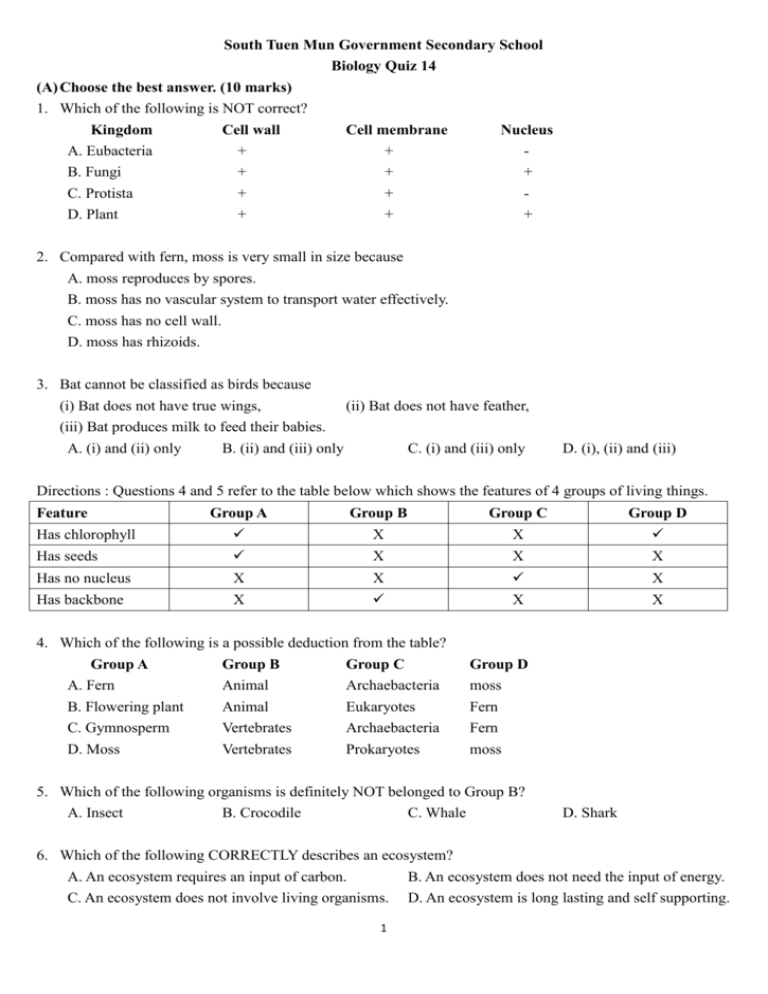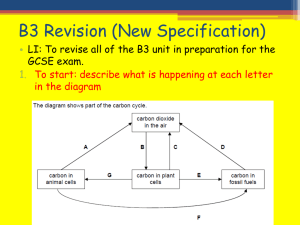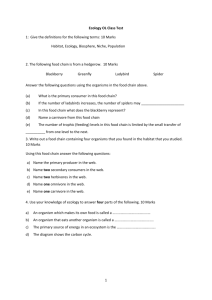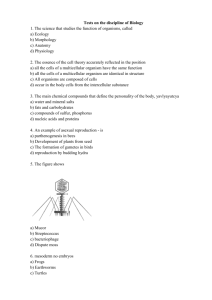Quiz 14
advertisement

South Tuen Mun Government Secondary School Biology Quiz 14 (A) Choose the best answer. (10 marks) 1. Which of the following is NOT correct? Kingdom A. Eubacteria B. Fungi C. Protista D. Plant Cell wall + + + + Cell membrane + + + + Nucleus + + 2. Compared with fern, moss is very small in size because A. moss reproduces by spores. B. moss has no vascular system to transport water effectively. C. moss has no cell wall. D. moss has rhizoids. 3. Bat cannot be classified as birds because (i) Bat does not have true wings, (ii) Bat does not have feather, (iii) Bat produces milk to feed their babies. A. (i) and (ii) only B. (ii) and (iii) only C. (i) and (iii) only D. (i), (ii) and (iii) Directions : Questions 4 and 5 refer to the table below which shows the features of 4 groups of living things. Feature Group A Group B Group C Group D Has chlorophyll X X Has seeds X X X Has no nucleus X X X Has backbone X X X 4. Which of the following is a possible deduction from the table? Group A A. Fern B. Flowering plant C. Gymnosperm Group B Animal Animal Vertebrates Group C Archaebacteria Eukaryotes Archaebacteria Group D moss Fern Fern D. Moss Vertebrates Prokaryotes moss 5. Which of the following organisms is definitely NOT belonged to Group B? A. Insect B. Crocodile C. Whale D. Shark 6. Which of the following CORRECTLY describes an ecosystem? A. An ecosystem requires an input of carbon. B. An ecosystem does not need the input of energy. C. An ecosystem does not involve living organisms. D. An ecosystem is long lasting and self supporting. 1 7. The relationship between bacteria that feed inside a living man is called A. competition. B. decomposition. C. mutualism. D. parasitism. 8. Between two trophic levels, energy is lost because (i) some living organisms of the lower trophic level are not eaten by their predators, (ii) some parts of the eaten prey cannot be digested and absorbed by the living organisms of a higher trophic level, (iii) the living organisms of one trophic level lose heat by respiration. A. (i) and (ii) only B. (ii) and (iii) only C. (i) and (iii) only D. (i), (ii) and (iii) 9. In the recycle of carbon compound, which of the following organisms is required to convert carbon dioxide into organic form of carbon compound? A. producer B. consumer C. herbivore D. decomposer 10. In the nitrogen cycle, ammonia is changed to nitrate by the process of A. decomposition. B. putrefaction. C. nitrification . D. denitrification. (B) Answer the following questions. (30 marks) 1. The diagram below shows a food web. (a) American Alligator and raccoon are put into two different groups in the animal kingdom. Name these two groups and state ONE external feature that can be used to distinguish the two groups. (4 marks) (b) (i) Write ONE shortest food chain in the food web. (1 mark) (ii) Using this shortest food chain, draw the pyramid of number with the living organisms involved. (2 marks) (c) (i) How many living organisms are found in the longest food chain of this food web? (1 mark) (ii) Explain why a food chain seldom exceeds the number of living organisms in (i). (3 marks) (d) (i) What is the relationship between Grass Carp and Eastern Mud Turtle in the food web? (1 mark) (ii) What will happen to the population of Eastern Mud Turtle in the food web if Grass Carp is suddenly removed totally from the food web? Give ONE reason for your answer. (3 marks) 2 2. The diagram below shows a simplified nitrogen cycle: (a) (i) If each of the boxes A, B, C and D represents a living organism involved in nitrogen cycle, match the boxes A, B, C and D with the living organism of (1), (2), (3) and (4) below: (2 marks) (1) plant (2) nitrifying bacteria (3) animal (4) nitrogen fixing bacteria (ii) If each of the boxes A, B, C and D represents a process in nitrogen cycle, match the boxes A, B, C and D with the processes (5), (6), (7) and (8) below: (2 marks) (5) nitrification (6) excretion (7) nitrogen fixation (8) absorption (b) Legumes contain organism C in the root nodules. Explain why growing legumes can improve the soil fertility on a farmland. (3 marks) 3. A piece of farmland had been abandoned (stopped to be used to grow crop). The main plant species living in the farmland in the next 300 years were recorded as shown in the diagram below: (a) What type of ecological succession had occurred in the abandoned farmland? Explain your answer. (2 marks) (b) Explain why big trees (like the big tree in (5) cannot grow in the abandoned farmland in the first 50 years. (3 marks) (c) Based on your biological knowledge, compare the abundance and diversity of the organisms on the farmland at year 50 and year 300. Explain your answer. (3 marks) 3 South Tuen Mun Government Secondary School Biology Quiz 14 Marking Scheme (A) Choose the best answer. (10 marks) 1. C 2. B 6. D 7. D 3. B 8. A 4. C 9. A 5. A 10. C (B) Answer the following questions. (30 marks) * spelling must be correct 1. (a) American Alligator belongs to * reptile (1) and raccoon belongs to * mammal (1). To distinguish the two groups, American Alligator has hard dry scale on its body surface (1) while raccoon has hair (1). [Accept : raccoon has mammary gland while American Alligator has not (2)] (b) (i) bladderwort Eastern Mud Turtle / Grass Carp American Alligator (1) [Do not accept the food chain starting with the sun] (ii) Title (½) – Pyramid of number in the shortest food chain Shape of the pyramid (1) Label (½) (c) (i) 5 (1) (ii) The longest food chain seldom exceeds 5 living organisms because energy is lost (1) by respiration, excretion, death, uneaten parts [Any ONE] (1), thus at the 5th living organisms, the energy inside its body is too little to support another organism of a higher trophic level (1). (d) (i) Competition (1) (ii) The population of Eastern Mud Turtle increases (1), because Eastern Mud Turtle has more food to eat (1), thus they can grow and reproduce faster (1). 2. (a) (i) A – (1) (½) B – (3) (½) C – (4) (½) D – (2) (½) (ii) A – (8) (½) B – (6) (½) C – (7) (½) D – (5) (½) (b) Legume fixed nitrogen in air to form ammonium compounds that is used to make protein in the legume (1). Ammonium compounds are broken down into nitrate by nitrifying bacteria (1). The increase in nitrate content in the soil makes the soil more fertile. (1) 3. (a) secondary succession (1) because before the farmland is abandoned, there are crops and other plants living in the farmland (1) (b) The big tree cannot grow because it requires a large amount of water and minerals for growth (1), when the farmland is abandoned, the soil minerals are likely depleted by the growth of crops (1) and the soil texture is poor so that the soil in the farmland cannot retain too much water (1). (c) The farmland at 300 year would have greater abundance and diversity of organisms as compared with those at 50 year (1) because big tree has a greater photosynthetic rate, so more food can be produced for a variety of living organisms in the farmland (1); moreover, big tree creates a more complex ecosystem with a variety of microhabitat, that allows a more diverse form of living organisms in there. (1) 4






